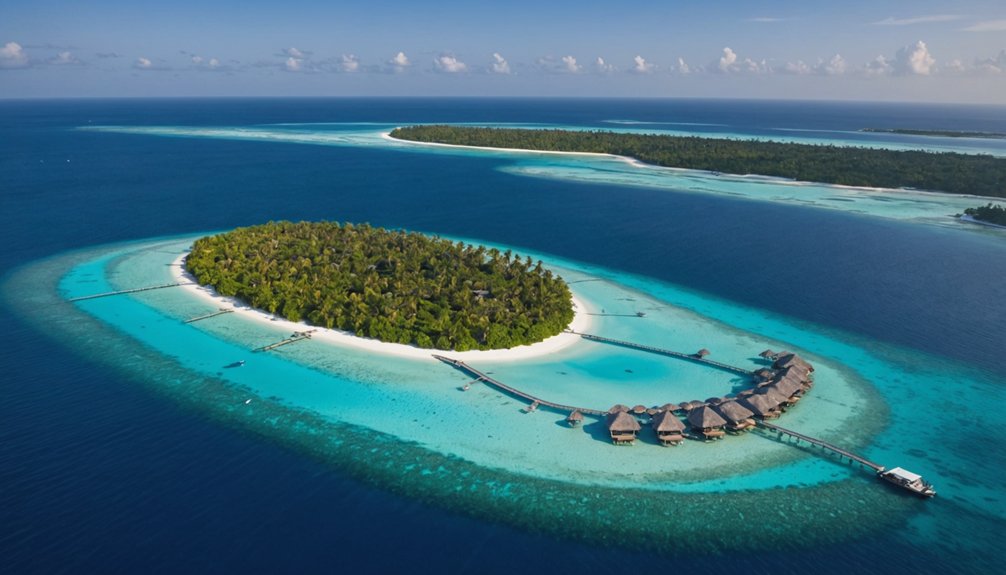The best time to visit the Maldives is during the dry season from December to April, when you’ll enjoy perfect temperatures of 28°C-31°C, crystal-clear skies, and minimal rainfall. You can expect 8-10 hours of daily sunshine, making it ideal for photography and water activities. While the wet season offers significant discounts of up to 70% at luxury resorts, the dry season guarantees excellent conditions for spotting sperm whales and exploring the vibrant marine life. The northern atolls hold even more secrets for those seeking the ultimate Maldivian experience.
Key Takeaways
- December to April offers ideal weather with temperatures of 28-31°C, minimal rainfall, and crystal-clear skies perfect for photography.
- The wet season (May-November) provides excellent value with up to 70% discounts on luxury resorts and fewer tourists.
- Marine wildlife enthusiasts should visit August-November for whale sharks and manta rays, or December-April for sperm whales.
- Local cultural experiences are best during religious festivals like Eid celebrations, featuring traditional dances and craft demonstrations.
- Visit during midweek in May-November for the most cost-effective travel deals on flights and accommodations.
Perfect Weather During the Dry Season
The Maldives comes alive during its dry season from December to April, offering visitors the most spectacular weather conditions imaginable. You’ll experience consistently pleasant temperatures between 28°C-31°C, with minimal rainfall dropping below 100mm monthly during February and March. These conditions create ideal photography conditions with crystal-clear skies and enhanced visibility.
The sea temperature remains warm year-round, typically ranging between 28-30°C. The northern atolls provide the most pronounced dry weather, perfect for those seeking guaranteed sunshine with over 250 hours monthly. You’ll enjoy 8-10 hours of daily sunshine, though you’ll need robust sun protection with UV indexes reaching 10-12. The marine environment becomes exceptionally inviting, with visibility extending beyond 30 meters for diving and snorkeling enthusiasts.
March and April bring peak temperatures of 32°C-33°C, coinciding with coral spawning events. Despite being peak season, strategic timing between major holidays can help you avoid the most substantial tourist crowds while still enjoying the perfect weather conditions.
Advantages of Visiting in the Wet Season
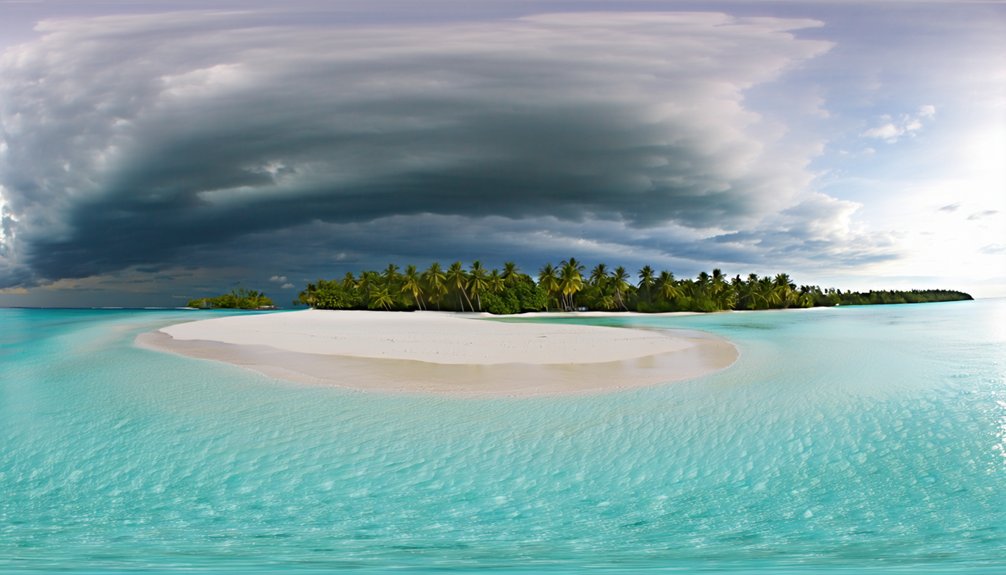
While peak season boasts pristine weather, savvy travelers are discovering incredible advantages to visiting the Maldives during its wet season from May to November. You’ll find luxury resorts slashing their rates by up to 70%, transforming once-exclusive properties into attainable paradise escapes. Imagine booking the same overwater villa at JW Marriott for $650 instead of $1,800 per night.
With resorts operating at just 30-50% capacity, you’ll experience enhanced service standards that feel truly exclusive. The cooler breeze makes outdoor activities more comfortable during this time. Couple’s pampering packages become more accessible, featuring complimentary upgrades and private dining experiences. The weather remains pleasantly warm at 28-30°C, with brief rain showers typically lasting under an hour.
You’re free to extend your stay longer, thanks to significant savings, and you’ll enjoy immediate access to premium amenities without the crowds. Plus, you’ll discover unique seasonal experiences, from world-class surfing conditions to cultural celebrations like Independence Day festivities.
Wildlife and Marine Life Encounters
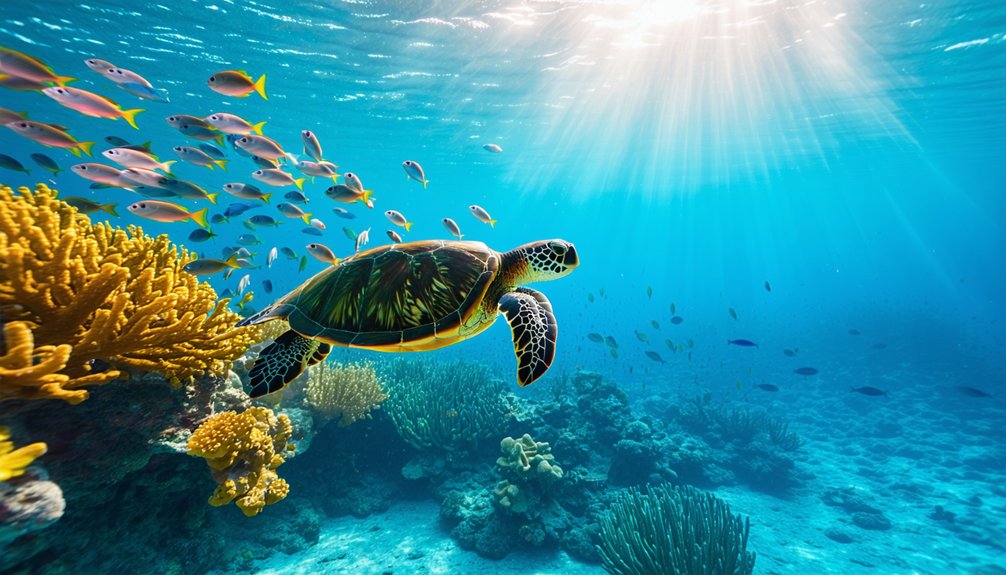
Searching for incredible marine encounters? The Maldives offers spectacular seasonal wildlife viewing with predictable whale shark aggregations and manta ray migrations. You’ll find these gentle giants in specific locations throughout the year.
| Season | Key Species | Prime Location |
|---|---|---|
| Dec-Apr | Sperm Whales | Deep Atolls |
| Jun-Nov | Manta Rays | Hanifaru Bay |
| Aug-Nov | Whale Sharks | South Ari Atoll |
The marine biodiversity here is astounding, with over 2,000 fish species inhabiting the eighth-largest coral reef system globally. You can swim alongside hawksbill turtles in North Malé Atoll or spot rare tiger sharks in Fuvahmulah. For night adventure seekers, the waters transform after dark with bioluminescent plankton creating a mystical underwater light show. Blacktip reef sharks hunt in shallow lagoons, while octopuses and squids emerge from their daytime hideouts. The Baa Atoll UNESCO site showcases extraordinary biodiversity with its rare pink hydrozoan corals and distinct benthic fauna. The protected areas enforce strict no-touch policies, ensuring sustainable wildlife encounters for future generations.
Cultural Celebrations and Local Events
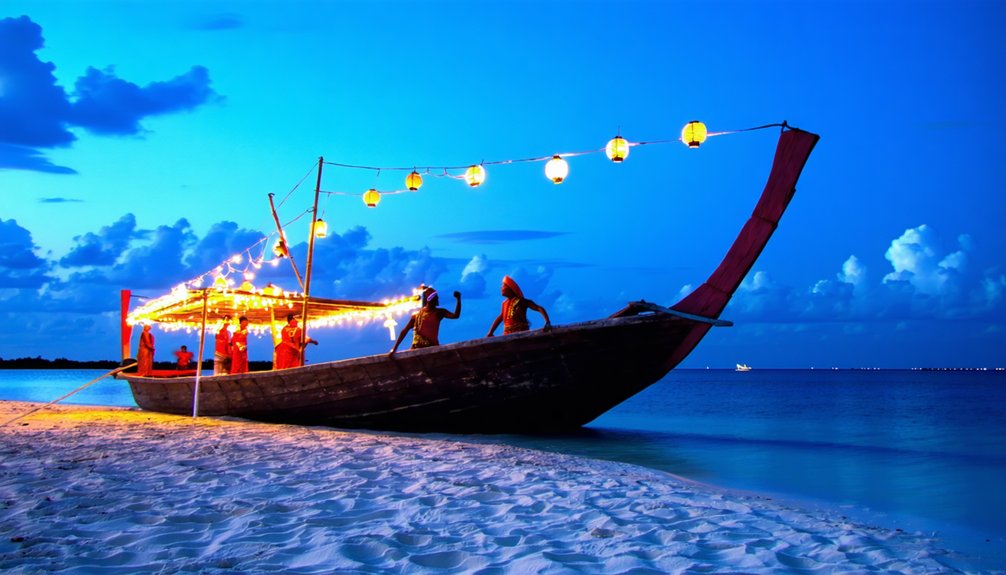
Rich cultural celebrations punctuate the Maldivian calendar year-round, offering visitors incredible opportunities to experience local traditions and festivities. You’ll find vibrant religious festivals like Eid-ul-Fitr and Eid-ul-Adha, where communities gather for traditional dances, feasts, and ceremonies.
During Ramadan observances (March-April 2025), you can witness evening Iftar meals featuring local delicacies like garudhiya and huni roshi, though tourist resorts maintain regular services. Special resorts host festive holiday events featuring lavish buffets and entertainment throughout December. Local island traditions come alive during national celebrations, with Independence Day parades, Victory Day military displays, and Republic Day flag-raising ceremonies creating memorable spectacles.
Don’t miss the cultural performances throughout the year, especially the mesmerizing Maali Neshun dances during Bodu Eid and traditional bodu beru drumming shows. You’ll also discover authentic craftsmanship at workshops featuring lacquerwork and mat weaving, while local markets showcase handmade souvenirs and traditional Maldivian cuisine year-round.
Money-Saving Travel Tips and Low Season Deals
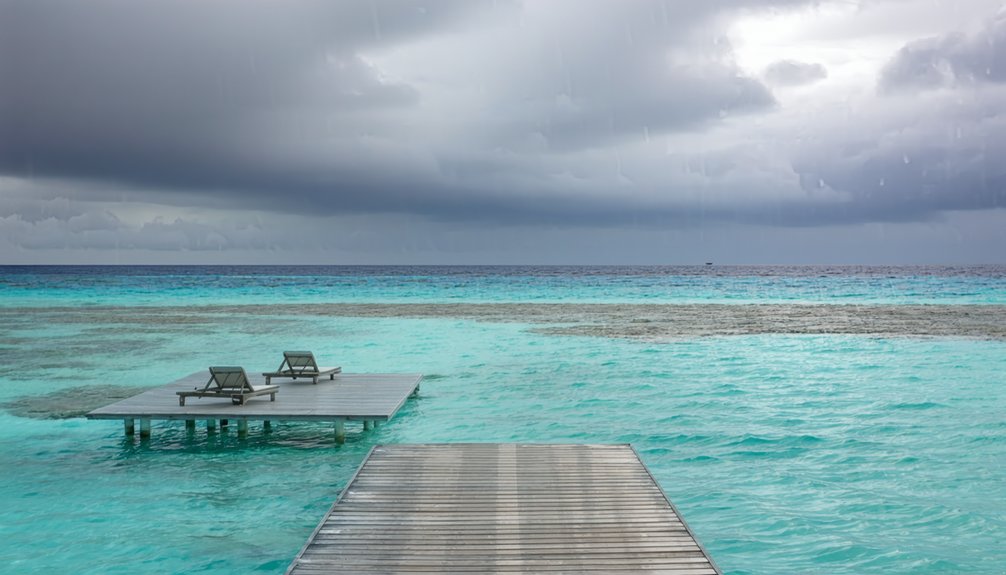
Looking to experience the Maldives without breaking the bank? Plan your visit during the low season (May-November) when prices drop considerably across accommodations and flights. You’ll find overwater villas and luxury resorts offering 30-50% discounts, while budget-friendly excursions like snorkeling and bioluminescent plankton tours come at minimal cost.
For maximum savings, consider splitting your stay between local islands and resorts. Local guesthouses provide authentic experiences for $30-80 per night, complete with breakfast and gear rentals. You’ll discover cost-effective dining options on local islands, where meals average just $10 daily, compared to resort prices exceeding $100. During your stay, you might catch exciting Independence Day celebrations in July.
Book flights midweek during May-November to secure the best deals, with airfares reduced by 20-40%. Despite occasional rain showers, you’ll still enjoy 6-8 hours of daily sunshine and perfect water temperatures for swimming. Plus, the reduced tourist traffic during low season offers better chances of spotting marine wildlife.
Sports and Adventure Activities
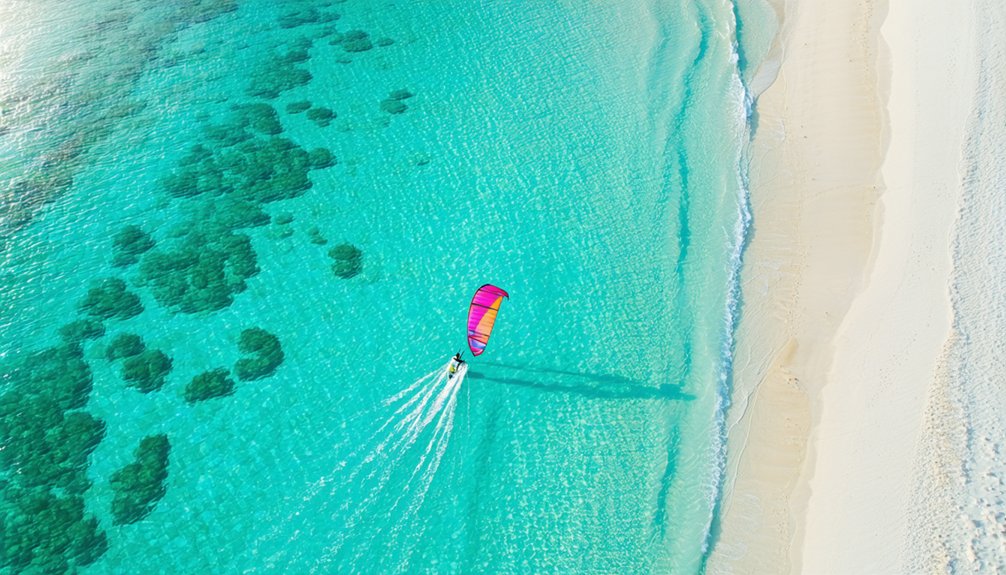
You’ll find prime surfing conditions from April to October when consistent winds create perfect waves for both beginners and advanced riders. For underwater exploration, visibility reaches its peak between December and April with crystal-clear waters extending 30-40 meters, though scuba experiences remain excellent year-round with varying marine life encounters. While peak season offers ideal conditions for most water sports, the monsoon period brings unique opportunities for specialized activities like manta ray watching and whale shark encounters. Popular activities like parasailing, wakeboarding, and windsurfing are best enjoyed during the May to October season, when weather conditions are most favorable.
Peak Surfing Months
The Maldives offers prime surfing conditions across three distinct peak seasons, with the main surf window spanning from February through October. You’ll find the most consistent swells from March to May and September to November, with uncrowded waves particularly abundant in the Northern Atolls.
For the biggest thrills, target June through September when Indian Ocean storms generate powerful 6-8 foot waves. The Male and Central Atolls benefit from ideal wind conditions during May-September, with offshore winds creating pristine surf faces. If you’re seeking mellower sessions, the shoulder seasons of March/April and October/November deliver cleaner, more manageable waves in the 3-5 foot range. The Southern Atolls shine during February-April and September-November, offering an escape from strong trade winds and peak tourist crowds. The dry season weather from mid-December to mid-April ensures maximum sunny days for optimal surfing visibility.
Diving Conditions Year-Round
While surfing draws many to the Maldives’ surface breaks, underwater enthusiasts will find a year-round paradise beneath the waves. The archipelago’s diving conditions shift dramatically with the seasons, offering unique experiences throughout the year.
Each season brings distinct underwater encounters:
- January-April delivers crystal-clear visibility up to 30m with calm seas
- May-October attracts plankton feeders and manta rays to cleaning stations
- November-December features spectacular manta congregations at Hanifaru Bay
- December-April’s mild currents create perfect drift diving conditions
- May-November’s plankton-rich waters draw massive whale sharks
For optimal equipment protection and comfort, diving experts recommend wearing a 3mm wetsuit during extended underwater sessions. Whether you’re exploring pristine reefs during peak season or witnessing feeding frenzies in the monsoon months, you’ll discover the Maldives’ underwater domain adapts to nature’s rhythm, rewarding divers with extraordinary marine encounters throughout the year.

